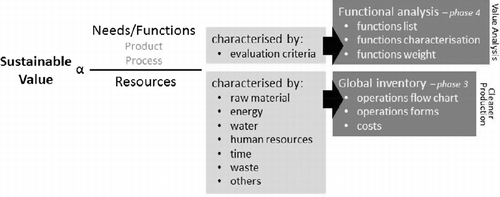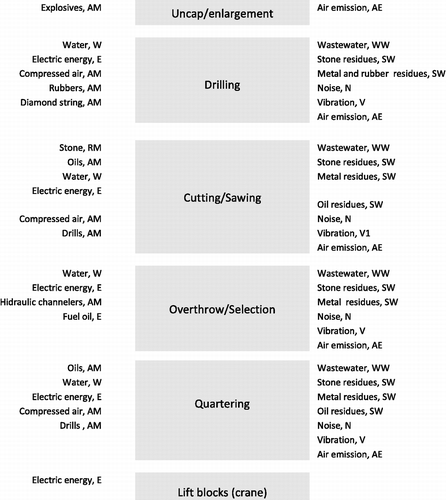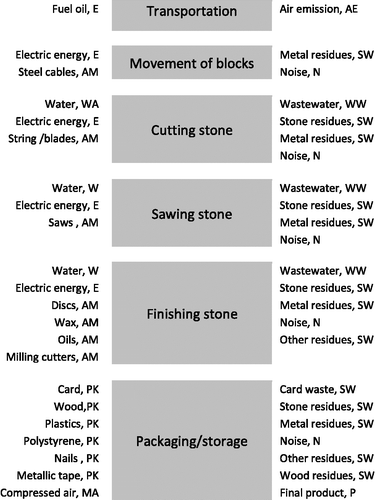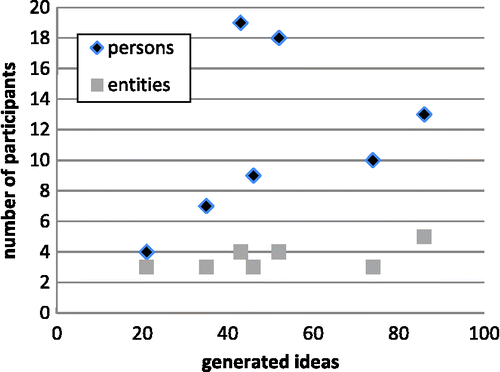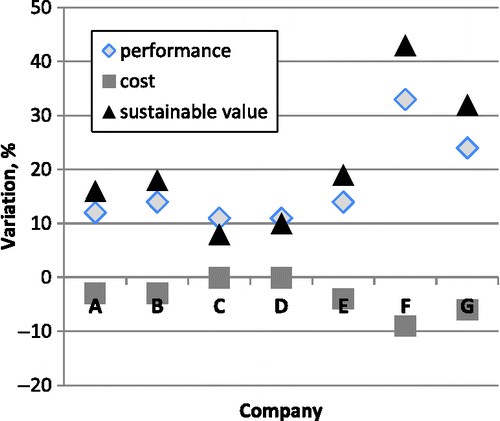Abstract
The activities developed within an eco-efficiency project in mineral industries located in the largest area for marble extraction in Portugal, in Alentejo region, in the Estremoz – Borba and Vila Viçosa anticline are presented in this paper. The project was designed to apply the sustainability concept in seven companies of marble extraction and transformation. The adopted strategy used new cleaner production models together with sustainable value (SV) improvement, leading to the rationalization of the industrial process, the involvement of economic agents and the orientation of the management of production processes towards eco-efficiency. The challenge was to have the mineral industry managing efficiently the resources on which the business depends, according to sustainability principles. Different opportunities for improvement, related to the minimization of materials, water and energy use, were identified in the companies. Some proposals mainly related to social improvement and small and medium-sized enterprise competitiveness benefits were also selected and discussed. This approach allows the integration of sustainability at company's and region's levels by combining in the entrepreneurial activity the creation of wealth together with the environment protection and the achieving of social benefits. Highlights: The involvement of different stakeholders in the project (Eco-efficiency in Portuguese companies of marble sector) was positive in the discussion and search of solutions for companies. It is possible to involve marble extraction and processing companies in eco-efficiency improvement towards sustainability. Companies from the marble sector improved environmental and social performance and reduced the costs of their production processes by applying SV methodology.
1. Introduction
1.1 Sustainability in the mineral sector
Mineral extraction activities, by providing raw materials, play an important part in a country economical position but they also represent environmental negative effects for local communities and the landscape. Marble, used in construction, is one of those materials, being its production limited to a certain number of countries. The European Union (EU) supplies represent about 17% of world extraction (Traverso, Rizzo, and Finkbeiner Citation2010).
Although the negative impacts have been detected long ago, nowadays there is a progressive awareness from entrepreneurs in order to minimize them in the mineral extraction and processing activities. The concern about sustainable development, defined by Word Business Council for Sustainable Development (Citation2006) as forms of progress that meet the needs of the present without compromising the ability of future generations to meet their needs, is not a new one for the sector that has always been appointed by the impacts of its activities either at the environment or social levels.
Wherever mineral extraction exists, it will affect to a certain extent either environment or local communities. Anyway those impacts can be minimized, if the enterprises adopt a responsible behaviour towards resource exploitation and transformation and all the stakeholders (Miranda, Chambers, and Coumans Citation2005).
In spite of the unquestionable importance of the mineral industry to the countries' development, governments must assure that mineral resource exploitation respects environment, human rights and society in a general way and does not consider only economic aspects. More often than desirable the harmful effects of an irresponsible exploitation of resources can be seen, thus risking the well-being of present and future generations (United Nations Citation2003).
The challenge is to have the extraction industry together with the processing of the raw materials managing efficiently the resources on which the business depends, according to sustainability principles, and therefore the importance of research and implementation of innovative approaches, involving the different stakeholders in the discussion and search of solutions for the companies and regions.
1.2 The Portuguese marble scenario
Portugal is one of the main world producers of ornamental stones. After Italy, Portugal is the bigger world exporter per capita, China, France, Spain and Saudi Arabia being the main importers (AICEP Citation2012). Marble and limestone sectors increased exports to China by 50% in 2010, with a turnover of about 50 million euros. Quality, beauty and reputation are the main attributes of Portuguese stone, whose exports increased 28% in the first trimester of 2012, the biggest increase in the last 5 years, when the European markets began to contract.
The situation in Portugal in 2010, in what concerns marble and ornamental limestone was: 162 enterprises; 1081 workers; 9,87,683 t produced and 87,567 × 103 euro (DGEG Citation2011). This sector is responsible for 1.5% of the country exports, maintaining a positive commercial balance, proving the strong impact of this industry in Portuguese economy.
The marble industry is very relevant in the Portuguese context of ornamental stones, particularly in the region of Estremoz-Borba-Vila Viçosa anticline, in Alentejo, one of the poorest regions at the EU level, an economically depressed area where the extractive industry makes a significant contribution to the local economy, in the form of both direct and indirect employment (EU Citation2007). Here is located the most important ornamental rock deposit of Portugal that has been explored since the Roman times and is still today the main centre of marble extraction in Portugal due to its characteristics and exclusive beauty (Guerreiro Citation2000; Carvalho et al. Citation2008).
This region, having unique geological characteristics in the country, has been intensively exploited, for the last decades, with inadequate practices in what concerns environment, local communities and landscape recovery. Landscape drastic changes caused by quarry rubble deposits and by deep craters near the inhabitants and roads, clearly show the effects of the extraction activities performed for years in this region, becoming clearly worse as the activity is increasingly being left. Other aspects to be considered are related to the high production of slurry and dust, water consumption, noise, and vibrations levels as a result of industrial activity (Guerreiro Citation2000).
Most of the Portuguese companies in the mineral sector, as happens worldwide, are small and medium ones and their activity has a low productivity. New technologies are not often considered, production costs are high and sustainability is not a priority. The result is the production of a very high level of waste material (Gazi, Skevis, and Founti Citation2012).
This scenario should desirably change. Portugal, as Member State of EU, subscribed the concept of sustainable development as all the other Member States have done (EU Citation2007; COM 670 Citation2005) and has published a National Strategy for Geological Resources. This strategy recognizes the importance of the extractive industry in contemporary society by creating opportunities namely for growth and development, stating, however, that sustainable development implies that such benefits should be obtained without compromising environmental, social and cultural conditions and without any long-term negative impacts (RCM Citation2012).
Several entities in the Alentejo's region have also, for decades, paid special attention to this activity:
Universities, by using quarries as geology ‘open books’, equipments and techniques demonstration fields, inspiring several research works and themes in this area.
The Technological Centre with a strong link with companies and training activity namely in what concerns the activity regulations and good practices implementation.
Entities linked to public administration and thus allocating funds to implement actions in order to minimize problems concerning environment impact, territory policies health and safety risks for population and workmen.
Companies that although with increasing difficulties, either due to deposits shortage or sales decrease, keep themselves receptive to new ideas and solutions.
1.3 Approach to sustainability in marble extraction and transformation companies
Society's understanding of what business is expected to contribute for sustainable development has advanced massively. This is no longer about corporate philanthropy or even narrow iterations of corporate social responsibility; companies are expected to create and share value and responsibility across a complex set of economic, social and environmental issues (Buxton Citation2012).
The expected answer from companies must consider sustainable production by creating goods, in a responsible attitude and competitive profit, using processes and systems that are non-polluting, that conserve energy and natural resources in economically viable, safe and healthy ways for employees, communities and consumers, and that are creatively rewarding for all stakeholders for the short and long terms (Glavic and Lukman Citation2007).
Various authors say that eco-efficiency (Schmidheiny Citation1992) can help the sustainable development of any kind of business activity (Howgrave-Graham and van Berkel Citation2007; van Berkel Citation2007). Moreover, other researches demonstrate that eco-efficiency is particularly useful for small and medium-sized enterprises (SMEs) in developing countries (Byung-Wook, Seung-Tae, and Jeong-Heui Citation2006).
The concept of sustainability is not difficult in understanding, but its implementation in operational terms has shown not to be an easy one (Briassoulis Citation2001). The mineral sector has been agreeing, at world level, that sustainable development is a key factor for its future development and for companies' success and that eco-efficiency with its environment preventive strategies as well as resources productivity ones, is essential for industry progress towards sustainable development (van Berkel Citation2007).
Eco-efficiency becomes then a management strategy towards sustainability by improving the economic and ecological efficiency of companies, attaining a higher value with fewer inputs, materials and energy and more outputs (product), but fewer waste, i.e. pollution in the form of emissions and residues. It lays on the prevention of materials, water and energy losses at the origin, leading to functioning costs reduction and to the improvement of the products environmental profile. The result is a higher value for companies as well as the increase of their competitiveness particularly for SMEs. In the past, companies looked at the environment and sustainability as problems, costs and risk factors, but today they see them also as opportunities – sources of efficiency improvement and growth.
The sustainable value methodology (SVM) is the result of the work of a research team in Laboratório Nacional de Energia e Geologia (LNEG), and integrates value analysis with eco-efficiency and cleaner production (CP) concepts. The complementarities between eco-efficiency (doing more with less) and value analysis (satisfying needs using fewer resources) are visible. Using the synergies between tools used by value management (value analysis as an example) and eco-efficiency (CP – UNEP 1990), the SVM was developed, and integrates the three aspects of sustainability (economic, environment and social) in SV concept (Figure ; Alexandre et al. Citation2007; Henriques et al. Citation2006, Citation2008; Catarino et al. Citation2011; Henriques and Catarino Citation2015, in press).
The concept of value has been used with different meanings and scopes in business world in the last centuries. More recently several authors introduced the concept of SV and those differences can also be found (Laszlo Citation2008; Figge and Hahn Citation2004, Citation2005; Hahn, Figge, and Barkemeyer Citation2007; Kuosmanen and Kuosmanen Citation2009).
If this present approach, which has been developed and applied since 2004, is compared with the one proposed for example by Figge, differences will also be found. Both approaches are based in the satisfaction of needs by goods and services and the use of economic, environment and social resources. In Figge's approach SV measures corporate contributions to sustainability by valuing resource use based on the opportunity cost, which must be estimated. The SVM approach follows the value definition in Value Management European Standard EN 1325-1: 2011, in which ‘value is the relationship between the satisfaction of needs and the resources used in achieving that satisfaction’ (Figure ) and explicitly takes into account the three dimensions of sustainability. According to EN 12973 value is not absolute but relative and may be viewed differently by different parties in different situations. It is an indicator that enables to compare initial value of a study subject to the proposals resulting from the methodology application. The optimization is achieved by balancing the amount to which needs are satisfied against the resources utilized in doing so.

The symbol α in Figure means that the relationship between needs and resources is only a representation and that they are traded off one against the other in order to obtain the most beneficial balance.
1.4 Objectives
The objective of this paper is to present the updating and development of a methodology implemented in the project ‘Eco-efficiency in Portuguese companies of marble sector’ in order to improve sustainability in companies of the marble sector, by improving environmental and economic performances and involving several stakeholders.
2. Methodology
The project ‘Eco-efficiency in Portuguese companies of the marble sector’ specifically proposes a new approach for business management and operation, based on eco-efficiency and sustainability principles. Pursuing enhanced eco-efficiency may act as a driver for innovation, improved productivity and hence competitiveness and growth.
This project was designed to apply the sustainability concept in a sample of companies of marble extraction and transformation in Alentejo region, Portugal (Henriques et al. Citation2009) but paying special attention to their transformation activities. The objective was to increase SV of companies' extraction and production processes and attain a multiplying effect of the results in other companies from that region.
The actions in Table were developed in order to reach the project's objectives.
Table 1 Project activities.
The SVM was implemented in each selected company according to the eight phases working plan (Table ).
Table 2 SVM phases.
Step by step, a diagnosis of environment, economic, social and functional problems of the study subject took place followed by the search of solutions to answer the problems that were found. Those solutions were evaluated taking into account all those aspects thus contributing to increase value in a sustainable way.
To create SV, the methodology starts from the environmental, economic and social characterization of the used resources by the enterprise and the evaluation of the level of satisfaction attained by the product and/or process that constitutes the study subject.
To support the implementation of the methodology in companies, a didactic manual with the description of each of its eight phases was produced.
The information collected during the application of the methodology was treated and the data obtained in each company were integrated in order to widen perspectives of the impact of the project Eco-efficiency in Portuguese companies of marble sector, either in terms of the environmental effects – reduction of companies' environment impacts – social improvement or economic savings as a result of ideas generated in each company.
A relationship between the number of ideas and stakeholders involved was searched as well as the evaluation of the integrated aspects related to performance, cost and SV variation for the companies studied subjects.
3. Results and discussion
After the kick off meeting, in the divulging action, seven companies from marble extraction or marble blocks transformation were selected, by the technological centre, according to a set of criteria previously defined, to apply SV methodology.
The stakeholders (local university, associations, technological centre and suppliers) were involved in several activities: the initial, intermediate and final seminars, as well as brainstorming sessions to generate ideas for improvement. Several institutions, from the region, participated in the initial seminar in order to know about the project and its objectives. In what concerns the companies they learnt about the project, their doubts were clarified and could apply as target enterprises. The information about the seminar was publicized by local press and through the entrepreneurial associations, technological centres and by a leaflet designed to present the project and to be spread among the population.
The intermediate seminars, in the workshop format, equipped the participants with new knowledge and innovation ability. This implied not only the reinforcement of R&D abilities within companies, but also the development of new competences. Those sessions were composed by a theoretical introduction to the theme, presentation of tools to implement preventive strategies in the companies, and then discussion, in group, based in case studies, examples and their own specific study subjects.
The knowledge, acquired in these sessions, enabled the selected companies and technological centre, to develop the project by practical implementation of the SV methodology under the research team supervision. As companies had results from the methodology application they were discussed during the workshops in a larger team (with all companies involved), with the objective of comparing experiences, detecting constraints and difficulties, correcting mistakes and analysing work development in each company. Those results were also an important input in what concerns the SVM and updates took place for future application.
The target enterprises involved in the project were mainly small ones, with 5–48 workers, located in the Portuguese Estremoz Anticline. Only one of them was certified according to ISO 9001 and ISO 14001. The activity of three of the enterprises is marble extraction and for the other ones it is marble processing into final products for the building-construction industry such as surfaces and paving. One of them has a rubble crushing plant to produce aggregates for construction, nearby the quarry.
With the support of worksheets, companies worked on the relationships with stakeholders and detected possible problems with workers, suppliers, clients, local communities and society. Generally there is a good relationship with workers and suppliers that support processes' and machinery's choice. Some problems arise in maintaining clients due to increasing difficulties regarding what concerns the traditional export of ornamental stones to Arabian countries. Local communities welcome the companies' activity as it represents a source of income to the region, but society in general does not have the same opinion as it consumes natural resources with a large amount of production waste. Another source of society disagreement is the practice of stone waste deposition in the anticline landscape.
According to Phase 2 of the methodology, the top management of each company selected the study subjects, and all of them chose the production process. One to three SME elements from quality, design/development, management, commercial departments were involved in the working team.
The main constraints faced by companies had to do with market retraction and the high percentage of material waste in the extraction and transformation processes.
During Phase 3, the processes (marble extraction or transformation) were studied leading to the manufacturing flow chart, operations description (namely raw materials, water, energy, products, waste and noise emission), mass and energy balance and cost diagram. General manufacturing flow charts obtained during Phase 3 are presented in Figures , where the main unitary operations for stone extraction, stone processing and auxiliary activities were identified. For each operation all the inputs (raw materials, RM; water, W; energy, E; auxiliary materials, AM; package materials, PK) and outputs (products, P; wastewater, WW; noise, N; wastes, SW; air emission, AE; vibrations, V; heat, H; water, W; auxiliary materials, AM) were identified and characterized. This analysis enabled the quantification of mass and energy balances and the resource costs. This information was used in the next phases of the methodology.
The work developed during Phase 4, functional analysis, lays one of the great differences between this approach and the traditional ones, being the study subject defined as a set of functions The main functions identified associated to stone extraction were:
to provide extraction – prepare slice cut;
to extract raw material – cut slice, select raw material and define stone blocks;
to transport stone blocks and
to manage waste.
to receive blocks; | |||||
to cut blocks – square, saw and cut blocks; | |||||
to cut plates; | |||||
to finish product (including or not polishing); | |||||
to pack product; | |||||
to dispatch product; | |||||
to store materials (blocks and product) and | |||||
to manage waste. | |||||
Considering all the target companies, a large number of different criteria (137) were used to characterize the functions and were distributed by different categories grouped in (1) economic/technical (including productivity, operation speed, maintenance, needs of area, noncompliance, operation time and other technical criteria), (2) environment and (3) social. They are presented (% of the number of criteria used in each category related to the total number of criteria) in Figure . Most of the criteria are technical/economic, the environmental and the other less used criteria became the social criteria. Only 3–5% of quarried stone is a valuable product (ornamental rock). Consequently, the large quantities of quarry rubble produced (‘stone residue’) are a common problem to all the companies. Therefore, productivity and operation speed were the most used criteria to characterize the companies' processes.
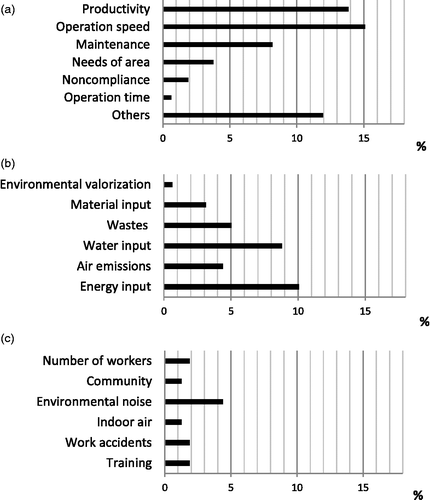
For the brainstorming sessions the team was enlarged with other participants, namely top management and in some cases external consultants, in order to have different views of the problems and to produce new ideas. By including several stakeholders during the implementation of the SVM a greater number of improvement ideas are obtained.
Generally, a larger number of people involved in the generation of new ideas implies the increase in the number of ideas obtained, as shown in Figure . This happened in teams up to 13 people, but in those with 18 and 19 people there was not any additional benefit which may indicate that the team dimension for ideas generation is beneficial up to a certain limit, which, in this particular case, was 13 persons.
Figure also shows that not only the number of people, but also the number of entities has influence in the number of ideas. The team with five different entities produced the larger number of ideas, with the enlarged team a great number of improvement ideas was generated during the creativity sessions. Then the working team in each company made a previous ideas' evaluation using the most adequate criteria according to the objectives and constraints settled during Phase 2. The ideas were classified according to the implementation times (short, medium long terms), CP techniques and eco-efficiency principles. Complementary ideas or related to the same problem were grouped and analysed as a whole in the next phases of the methodology.
In each company the selected ideas were developed as an individual project, costs were allocated and benefits either in economic terms or environment ones (e.g. use of resources reduction, emissions and residues generation) or social ones (company's image, stakeholders involvement, safety working conditions) were evaluated (Phase 8). After receiving this information top management, in each company, decided about investment plans.
The complete implementation of the methodology lasted for 2 years.
In a general way the ideas selected for implementation in SME involved led to the environmental impact reduction, to the enterprises social performance improvement and in every company to the increase of the SV of production processes.
Table presents some of the generated ideas and its environmental impact in what concerns reductions in resources (water and energy) consumption and also in the contribution for the greenhouse effect. Some ideas led to potential reductions up to 2000 m3/year or 67 t/year, per company. Although some measures increased the contribution for the greenhouse effect, potential reductions up to 177 t CO2 were also detected.
Table 3 Environment impacts reduction resulting from the ideas generated in each enterprise.
Concerning social aspects, the improvements led to a higher worker safety level, better image, reduction of work accidents and a better functional performance (Table ).
Table 4 Social aspects improvement as a result of ideas generated in each company.
Beyond the ideas for improvement in each company, some work between companies was developed. The problems were analysed and discussed and ideas for common improvement were generated. For example, neighbour quarries accorded to explore common boundary areas that could not be done by one alone. Another idea generated and analysed is related to quarry rubble crushing thus generating a new by-product to be supplied by this region and simultaneously reducing rubble deposits (and visual impact).
Following what is established in EN 12973, with data obtained in the SV methodology, in each company (A to G), the new performance and associated production costs for the ideas selected by top management were evaluated as well as the new SV of each study subject. In all of them there was a performance increase from 11% to 33% and cost reduction from 0.1% up to 9% (Figure ).
As a result of performance and cost variation, the SV increased from 8% to 43% thus also increasing companies' sustainability.
Beyond the specific results attained and the contribution to sustainable development in each company, other general ones can be pointed out (Table ).
Table 5 General results.
In the final workshop the seven companies directly involved presented the work developed, and it can be concluded that the active involvement of the different stakeholders, companies, technological centre, university, local authorities and population, strengthened the results and created a multiplying effect that helped the dissemination of this strategy to other companies involved in mineral extraction.
4. Conclusions
The SVM (based in EN 12973) went a step further in what concerns the application of the approaches of CP and value analysis. By using the specific tools of each of them, and profiting from their complementarities, the attained results can be improved.
The SVM supports companies in the improvement of their SV. This strategy improves the relationship between economic, environmental and social performance and the use of resources, thus leading to the improvement of eco-efficiency and competitiveness, based in an innovation entrepreneurial culture.
The functions identification and characterization of the study subjects helps CP classic methodology to include social, economic and environmental criteria, beyond the technical ones.
The SV indicator integrates entrepreneurial information about environmental, social and technical performance and costs.
The involvement of different stakeholders leads to a broader definition and analysis of the study subjects as well as to the searching of interesting solutions to several of the involved parts.
This approach involving companies in the implementation of a specific methodology to their processes leads to the success of their business management supported by sustainability principles. Anyway, future research in this direction is needed in order to advance and validate whether or not the results can be multiplied. This implies a long term follow-up in the companies involved.
Therefore further studies may be needed in order to understand the complex mechanisms of sustainability implementation due to different singularities. Another important step is the development of a more simplified methodology to be implemented in companies in a shorter period of time.
Acknowledgements
This work was possible due to the involvement of the Technological Center, namely in the promotion activities, the other regional entities and LNEG's colleagues that collaborated in the project.
Notes
1. Email: [email protected]
References
- AICEP. 2012. Accessed October 2012. http://www.portugalglobal.pt “Portugal Global.” 49.
- Alexandre, J., A. Maia, D. Camocho, F. Rodrigues, J. Henriques, and J. Catarino. 2007. “How to Measure the Value from a Sustainable Point of View, Value World.” SAVE International 30 (3): 9.
- van Berkel, R. 2007. “Eco-Efficiency in the Australian Minerals Processing Sector.” Journal of Cleaner Production 15: 772–781.
- Briassoulis, H. 2001. “Sustainable Development and its Indicators: Through a (Planner's) Glass Darkly.” Journal of Environmental Planning and Management 44 (3): 409–427.
- Buxton, A. 2012. “MMSD+10: Reflecting on a Decade of Mining and Sustainable Development.”. IIE D Discussion Paper. London: International Institute for Environment and Development.
- Byung-Wook, L., J. Seung-Tae, and K. Jeong-Heui. 2006. “Environmental Accounting Guidelines and Corporate Cases in Korea. Implications for Developing Countries.” In Implementing Environmental Management Accounting: Status and Challenges, 239–255. Dordrecht, Netherlands: Springer.
- Carvalho, J., P. Henriques, P. Falé, and G. Luis. 2008. “Decision Criteria for the Exploration of Ornamental-Stone Deposits: Application to the Marbles of the Portuguese Estremoz Anticline.” International Journal of Rock Mechanics & Mining Sciences 45: 1306–1319.
- Catarino, J., J. Henriques, A. Maia, J. Alexandre, F. Rodrigues, and D. Camocho. 2011. “From Cleaner Production and Value Management to Sustainable Value.” International Journal of Sustainable Engineering 4 (2): 96–108.
- COM 670. 2005. “Communication from the Commission to the Council, the European Parliament, the European Economic and Social Committee and the Committee of the Regions - Thematic Strategy on the Sustainable Use of Natural Resources”
- DGEG. 2011. Informação estatística da Indústria Extrativa [Mining industry statistical Information]. Vol. 13. Lisbon, Portugal: Head office for Energy and Geology.
- EU. 2007. “Commission Staff Working Document – Analysis of the Competitiveness of the Non-Energy Extractive Industry in the EU/SEC/2007/0771”
- European Standard EN 12973. 2000. “Value Management”. CEN/TC 279 - Value management - Value analysis, function analysis, 2000.
- European Standard EN 1325-1. 2001. “Value Management, Value Analysis, Functional Analysis Vocabulary - Part 1: Value Analysis and Functional Analysis.” CEN/TC 279 - Value management - Value analysis, function analysis, 2001.
- Figge, F., and T. Hahn. 2004. “Sustainable Value Added – Measuring Corporate Contributions to Sustainability Beyond Eco-Efficiency.” Ecological Economics 48: 173–187.
- Figge, F., and T. Hahn. 2005. “The Cost of Sustainability Capital and the Creation of Sustainable Value by Companies.” Journal of Industrial Ecology 9: 47–58.
- Gazi, A., G. Skevis, and M. A. Founti. 2012. “Energy Efficiency and Environmental Assessment of a Typical Marble Quarry and Processing Plant.” Journal of Cleaner Production 32: 10–21.
- Glavic, P., and R. Lukman. 2007. “Review of Sustainability Terms and Their Definitions.” Journal of Cleaner Production 15: 1875–1885.
- Guerreiro, H. J. P. 2000. “Exploração Subterrânea de mármores – Aspetos geotécnicos [Marble underground exploitation - geotechnical aspects].” IST, MSc Thesis, Lisbon.
- Hahn, T., F. Figge, and R. Barkemeyer. 2007. “Sustainable Value Creation Among Companies in the Manufacturing Sector.” Interational Journal of Environmental Technology and Management 7 (5/6): 496–512.
- Henriques, J., and J. Catarino. 2015, in press. “Sustainable Value and Cleaner Production – Research and Application in 19 Portuguese SME.” Journal of Cleaner Production 96: 379–386.
- Henriques, J., J. Catarino, J. Alexandre, and A. Maia. 2006. “Sustainable Value.” In 1st ICEC & IPMA Global Congress on Project Management, 5th World Congress on Cost Engineering, Project Management & Quantity Surveying, Ljubljana.
- Henriques, J., J. Catarino, J. Alexandre, A. Maia, F. Rodrigues, and D. Camocho. 2008. “Value Analysis – An Approach to Sustainability.” In The 9th HKIVM International Conference 2008, Hong Kong.
- Henriques, J., J. Catarino, A. Maia, F. Rodrigues, A. Alexandre, and N. Bonito. 2009. “Sustainable Value in Mineral Extractive Industry.” In 5th International Conference on Industrial Ecology, ISIE Conference Transitions Toward Sustainability, 116. Lisbon: Calouste Gulbenkian Foundation.
- Howgrave-Graham, A., and R. van Berkel. 2007. “Assessment of Cleaner Production Uptake: Method Development and Trial with Small Businesses in Western Australia.” Journal of Cleaner Production 15: 787–797.
- Kuosmanen, T., and N. Kuosmanen. 2009. “How Not to Measure Sustainable Value (and How One Might).” Ecological Economics 69: 235–243.
- Laszlo, C. 2008. Sustainable Value – How the World's Leading Companies are Doing Well by Doing Good. Sheffield, UK: Greenleaf Publishing. ISBN 978-1-906093-06-8.
- Miranda, M., D. Chambers, and C. Coumans. 2005. Framework for Responsible Mining: A Guide to Evolving Standards. Sydney, Australia: Center for Science in Public Participation.
- RCM. 2012. Resolução do Conselho de Ministros 78/2012 de 11/09/2012 – Estratégia nacional para os Recursos Geológicos – Recursos Minerais. [Council of Ministers Resolution nr 78/2012 from 11/09/2012 - National strategy for geological resources - mineral resources]. Lisbon, Portugal: Portuguese Government.
- Schmidheiny, S. 1992. Business Council for Sustainable Development – Changing Course: A Global Business Perspective on Development and the Environment. Cambridge, MA: MIT Press. ISBN 0-262-69153-1.
- Traverso, M., G. Rizzo, and M. Finkbeiner. 2010. “Environmental Performance of Building Materials: Life Cycle Assessment of a Typical Sicilian Marble.” International Journal Life Cycle Assess 15: 104–114.
- United Nations. 2003. A Manual for the Preparers and Users of Eco-Efficiency Indicators. UNCTAD/ITE/IPC/2003/7 UN Publication (Sales No. E.04.II.D. 13). New York and Geneva: United Nations. ISBN 92-1-112620-7.
- Word Business Council for Sustainable Development. 2006. Business for Development. Business Solutions in Support for Millennium Development Goals. Geneva, Switzerland: Atar Roto Presse SA.

